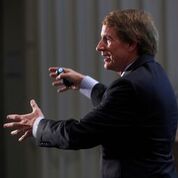With a discussion of El-Nino, climate change, Nor'easters and hurricanes, the Rosenstiel School of Marine and Atmospheric Science at the University of Miami launched its 2016 lecture series "Sea Secrets."
The timing couldn't have been more striking ... within 48 hours, Jonas, the "snowzilla" of a storm, would slam the Atlantic Coast with record snow, paralyzing the nation's capital for days and damaging coastlines with high-tide waves. The deadly blizzard of 2016 would break records, strand motorists, put homes in peril and affect 50 million people.
"While so many of us are fascinated by the unpredictability of our atmosphere, by the mysteries of our seas and by the powerful interaction of the two, science gives us clues to their secrets but not always all the answers," explained Dean Roni Avissar, Ph.D., as he opened the series.
Building on Rosenstiel's global leadership in education and research, the "Sea Secrets" lecture series creates a unique opportunity to bridge the academic and the practical.
And it does so by raising questions that are often on our minds, by challenging preconceived notions and by exploring more than just the science.
The first of "Sea Secrets" featured Bryan Norcross, hurricane specialist at the Weather Channel and internationally-recognized expert on hurricanes and typhoons. Against a backdrop of scientific studies, historic data, predictions gone awry and actual hurricane experience, he honed in on the challenge of how best to create an awareness of the impending dangers of hurricanes, without creating panic.
Research is key, he believes. But predicting hurricane paths is an inexact science. Different models create a rather wide cone, each trying to track the hurricane's direction as it approaches landfall. While the cone serves as a broad prediction and the science behind hurricane forecasting is slowly getting more accurate, even more is needed. The challenge is that some people become complacent while others react to what they perceive as impending disaster, with danger to life and property ready to hit their shores and homes.
Beyond the science, Norcross firmly believes that communications must be better addressed to help people understand and react appropriately whether or not they might be in the path of a major natural disaster - hurricane or other.
However, the communications surrounding an impending weather event too often leave people wondering and in doubt, especially in our age of digital messages. Messages and sources can be confusing. Speculation runs wild online with Tweets and posts. Fact, fiction and rumor are too often mixed. News and commentary comes from both experienced and inexperienced individuals and few can tell the difference. And, a mindset of 140 characters or less makes complete information scarce.
Norcross points to five stumbling blocks to providing clear messages:
- A fractured system of shorter messages
- Shorter attention spans
- Average communicator has less experience
- Message-delivery pathways are less resilient
- Fewer credible societal voices ... and more uninformed opinions
Without strong and informed communications from reliable sources, anxiety escalates and can make things worse. Some people overreact, some deny the risk, others become complacent.
While researchers and scientists are continually improving the ability to more accurately predict hurricanes, it is most often how we react that makes the critical difference when it comes to our safety.
This lecture series is another in a string of firsts for the Rosenstiel School and is in keeping with a view toward helping to improve lives through education and research in the applied sciences.
In the finest tradition of leadership, Rosenstiel last year opened its hurricane research building - The Alfred C. Glassell Sustain Laboratory - complete with a wind-wave-storm-surge simulator able to produce Category 5 force winds. Designed to measure air-sea interactions during hurricane conditions, this is a one-of-a-kind complex that permits scientific exploration like never before.
From now through April, "Sea Secrets" lectures will go on to explore killer whales and wild animals, research on the impact on the ocean of climate warming and CO2 emissions, and what science tells us about the effect that climate change has had on the rise and fall of civilizations through the centuries and around the world.
In what is one of the best examples of a partnership between sharing research from a world-class university and providing valuable insights to the public, "Sea Secrets" is made possible by many whose passion is to protect our environment and preserve our oceans: The Shepard Broad Foundation, Sheryl Gold, William J. Gallwey, III, Southern Wine & Spirits and WPBT PBS Miami.

